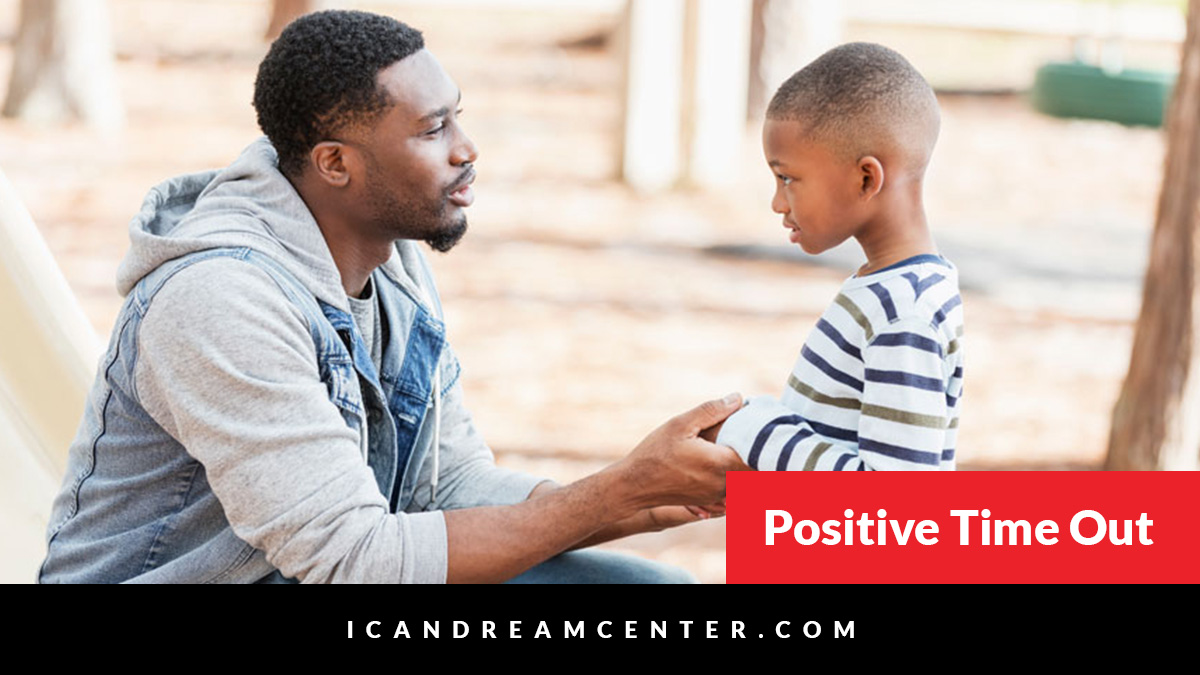
Positive Time Out
Many parents and teachers say, “Go to your room (or to the corner) and think about what you did.” Many parents are used to the approach to addressing behavior because that was the way they were parented.
Most adults do not realize that children are constantly making decisions about themselves, about their world, and based on those decisions, what to do to survive or to thrive.
Negative time out is based on the antiquated thought that to get children to do better, first we must make them feel worse. Positive time out is based on the understanding that children “do” better when they “feel” better. Check out these premises for yourself. Do you do better when you feel worse, or when you feel better?
It is fun to ask, “How would you respond if you spouse said to you, ‘Go to your room and think about what you just did!” Most people laugh and say something such as, “I don’t think so.” Why do we think negative time out would be effective for children when it wouldn’t be effective for us?
Negative time out is certainly not effective if it perpetuates a child’s discouraging beliefs about herself and her environment. Nor is it effective if those beliefs increase her need for revenge or rebellion in whatever form it takes.
The Effectiveness of Positive Time Out
On the other hand, positive time out can help children learn many important life skills, such as the importance of taking time to calm down until they can think more clearly and act more thoughtfully. When human beings are upset, they function from fight or flight.
Adults are often functioning from fight or flight when they send children to time out, and resentment will put children in their own state of fight or flight.
Positive time out allows children (and adults) space to calm down until they are again functioning from their rational brain (the cortex)—so they can problem-solve and learn. Positive time out encourages children to form positive beliefs about themselves, their world, and their behavior. In this state of mind, they can learn from their mistakes and/or problem solve on how to make amends for any hurt or damage their behavior might have caused.
When a method has really worked with children, they feel empowered and motivated to improve from an inner desire and locus of control (as opposed to control from others), and they develop skills that will help them solve problems and improve behavior.
Adults can empower children in these ways when they understand a few basic principles of human behavior:
Basic Principles of Human Behavior
- All people (including children) deserve dignity and respect. A basic principle of psychology—the philosophy of maintaining dignity and respect for all human beings–must be incorporated before time out can be used as an effective, encouraging experience that helps children, instead of an experience that creates humiliation and loss of dignity and respect.
- Misbehaving children are discouraged children. Misbehaving children are discouraged and need encouragement, so they won’t feel the need to misbehave; not shame and humiliation to make them feel more discouraged and more motivated to misbehave.
- Humiliation and shame are not effective motivators. Over the last decade, social workers have formally adopted positions in opposition to spanking, paddling, or humiliating children in any way. These specialists have paid attention to the research demonstrating that the long-range damage to children far outweighs the immediate advantage of controlling behavior through punishment.
Let it be stated again: “Where did we ever get the crazy idea that to make children do better, we must first make them feel worse?” The truth is that children do better when they feel better—not when they are discouraged about themselves. Therefore, the number one criterion for positive time out is that it be used to help children feel better, not to make them feel worse.
If Not Punitive Time Out, Then What?
Parents and teachers often tell us they have tried everything to deal with a misbehaving child, and that nothing works. When we ask them to list everything they have tried, everything on their list is punitive. Why is it so difficult for adults to give up punishment when they experience over and over that it doesn’t work? Answer: They are afraid the only alternative is permissiveness. Positive time out it not permissive.
Criteria for Positive Time Out
Positive time out is designed to encourage children and to teach them self-control and self-discipline. It is respectful because children are involved in the process (by helping to create a space that will be encouraging) instead of objects or victims of the process. Positive time out teaches children to understand that their brains don’t function well when they are upset. They learn the value of taking time out to calm down until their brains are functioning in a way that is advantageous to them, rather than detrimental.
The Sports Analogy
Before adults can convey the benefits of positive time out, they must get rid of their old ideas about punitive time out. Adults and school age children love the analogy of time out in sports where the purpose is to stop the clock, catch your breath, regroup, take a look at what isn’t working, and come up with a new plan. Positive time out can do the same for both children and adults. It can stop the clock on negative behavior and allow time for calming down before new behavior is possible. Since children do better when they feel better, they will be able to regroup and come up with a new plan that will serve them and others.
Another analogy that helps children and adults understand the benefits of positive time out as a nurturing experience is to think about the comfort of sitting on Grandma’s lap.
Self-Soothing
Anxiety is a normal component of living. We get anxious when we are scared, when we don’t get what we want, when we feel rejected, when we feel hurt, when we feel powerless. The list could go on and on.
The good news is that we are born with several coping (self-soothing) abilities and can learn other coping skills. The bad news is that many parents and teachers think good parenting and teaching means to distinguish children’s self-soothing abilities instead of allowing them to develop. These same parents and teachers avoid teaching additional self-soothing skills because they are so busy fixing every problem a child may encounter or using punishment for behavior instead of helping the children manage their own behavior.
Positive time out provides time for children to enhance their innate ability to self- soothe instead of having this ability extinguished by parents and teachers who overprotect or punish. Positive time out teaches the valuable life skill of learning to take time to feel what you feel, and to calm down until you can behave in more constructive ways.
